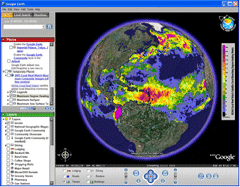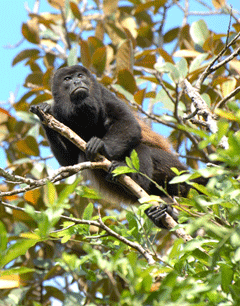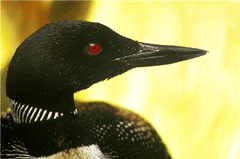Google Earth Finds its Voice
Air Date: Week of June 8, 2007

Typical Google Earth Screen (Courtesy of NOAA)
Sounds of a California sunrise, anemones singing, a busy Lisbon street…these are some of the recordings Bernie Krause has made during his 40 year career. Krause recently teamed up with Google Earth to add this and other audio to enhance the online satellite views of the world. He spoke with host Bruce Gellerman.
Transcript
GELLERMAN: Log on to Google Earth and you get a bird’s eye view of the globe. That is if the bird is a high-flying satellite able to see everything from the Great Wall of China to the car in your driveway. But you might want to pull down your window shades because Google has started offering street level views that allow you to peek inside buildings. Still, Google software is a great way to see the planet. And now you can use it to hear the Earth, as well.
[SONOMOA VALLEY SUNRISE]
This is what sunrise in Sonoma Valley, California sounds like. Dr. Bernie Krause recorded it. It’s one of over 1200 locations he’s recorded over a 40-year career. Dr. Krause is a bio-acoustician and president of Wild Sanctuary, an online audio archive. He recently teamed up with Google Earth to add sound to their service and he joins me from a studio in California. Dr. Krause, welcome.
KRAUSE: Thank you, Bruce.
GELLERMAN: Boy, who knew it was such a racket in Sonoma Valley, California.
KRAUSE: Can you believe that? This is one of those rare spots in Sonoma Valley that hasn’t been developed for wine and grapes. And it’s particularly beautiful because it’s one of those places that sounds like the earth sounded like 150 or 200 years ago.
GELLERMAN: Well, how does your work, your recordings, work with Google Earth? How do you add sound to a map?
KRAUSE: Well, if you can imagine the map, and when you zoom into Google Earth you zoom in from outer space to a point. And typically what happens is it looks like a silent movie. There’s this big globe out there and you move into a spot, and I began to layer sounds to these spots and it became so engaging we just thought, well maybe we should really try and approach Google and see if they’d be interested in adding it as a layer to their material.

Typical Google Earth Screen (Courtesy of NOAA)
KRAUSE: Well, what you would do is when it gets up, you go to the lower left hand part of the page and you’ll click a little box that will say soundscape. And when that box is checked as you’re zooming into that spot the sound will get louder and louder and louder to the point where when you’re a couple of thousand feet above that particular site you’ll hear the full range of sound.
GELLERMAN: So, I’m going to zoom over to Corcovado National Park in Costa Rica and let’s listen to what we get.
[HOWLER MONKEYS AND TREE FROG CALLS]
GELLERMAN: What is that Dr. Krause?
KRAUSE: Well, in the background you’re hearing a howler monkey. And then you’re hearing little tree frogs, little peepers, and some insects.
GELLERMAN: When did you make this?
KRAUSE: This was made in the early 90’s and it was a very special place then. It’s gone through some radical changes since global warming. And many of these sounds can’t be heard anymore. As a matter of fact, Bruce, 40 percent of my library that I’ve collected is from now extinct habitats or habitats so radically altered that you can’t hear those distinct sounds anymore.

A male mantled howler monkey in Costa Rica. (Photo: Leonardo C. Fleck.)
KRAUSE: Yes, I have before and after effects from many places on the planet, certainly not all of them but several of them.
GELLERMAN: Well, we have a recording here from Lincoln Meadow in the Sierra Mountains in California. Can you tell me what’s going on?
KRAUSE: Yeah, this is a recording that was made in 1988 in Lincoln Meadow, which is about 40 miles north of Truckee. The issue was raised by the logging companies whether or not there was going to be any effect as a result of selective logging. And they informed us that there wasn’t. There was going to be no biological effect. And sure enough when you go out there into the forest and you look at this beautiful meadow it looks absolutely gorgeous. And the same thing after. I mean to the human eye there is no change at all. But let’s listen to the sounds of this place. This is the before sound.
[SEVERAL VARIETIES OF BIRD CALLS]
GELLERMAN: Wow, that’s really beautiful.
KRAUSE: It’s so rich. And it’s got density and diversity to it.
GELLERMAN: Ok, let’s listen to the after.
[SOUND OF RUNNING WATER]
KRAUSE: This is a year later and 15 years hence it’s exactly the same.
GELLERMAN: You’re missing all the richness though.
KRAUSE: There’s nothing there. Now to the eye it looks absolutely the same. But the ear tells the truth. I like to say that you know a picture is worth a thousand words and a soundscape is worth a thousand pictures.
GELLERMAN: Now if I go to Google Earth can I hear the before and after?
KRAUSE: You will be able to hear the before and after because we plan on using that as one of the layers.
GELLERMAN: So, what you actually have are audio artifacts. These are things that no one will hear in the future.
KRAUSE: That’s correct. But you know, I’m ever hopeful, I’m an optimist. I believe that by bringing these things to people’s attention through things like Google Earth that they’re going to want to pay some more attention to it and just get out into the natural world and enjoy it for what it is. Because it’s one of those things that’s really an analgesic. It helps heal us.
GELLERMAN: Now, your recordings are not limited to just natural sounds from the environment. Am I right?
KRAUSE: That’s correct.
GELLERMAN: You also have sound of cities?
KRAUSE: Yes, we do and one of the things about Google Earth that was really interesting when we began to formulate sounds of these various places like for instance Lisbon, or Paris, or London, or New York each of them has their own sound signature. And it’s remarkable how different these places sound.
GELLERMAN: Let’s listen to Lisbon.
LOCAL MUSIC AND PEOPLE TALKING, MUSIC IN THE BACKGROUND
GELLERMAN: Do you remember recording it?
KRAUSE: Oh, sure. It was down near the Tagus River. I was just walking down the street with mikes on my shoulder so people wouldn’t notice it and just picked up the soundscape, same way I do pretty much all over cities in the world.
GELLERMAN: What’s the strangest place you’ve ever gone to record sounds?
KRAUSE: Wow, what a question. Nobody’s ever asked it that way, Bruce. Well, I guess it would be a tide pool in Alaska where we recorded anemones.
GELLERMAN: Anemones make sound?
KRAUSE: They sing.
[SEA ANEMONE SOUNDS]
KRAUSE: What we did is we dropped a hydrophone down the mouthpart, the center part of the anemone. And then the tentacles, you’re hearing the tentacles wrap around it, those gentle little clicking sounds because it’s looking for something of nutritional value. And then when it finds nothing of nutritional value you hear:
[ANEMONE HONKING SOUND]
KRAUSE: It sounds like a belch.
GELLERMAN: Now, you’ve listened to these tapes over and over again. Do you get something different when you listen to them and view Google Earth?
KRAUSE: Oh, there’s no question about it because it brings that Google Earth experience to life. It gives it life and that’s the one thing that soundscapes do.
GELLERMAN: So, Dr. Krause, before I let you go let’s listen to one more piece of sound. What do you got?
KRAUSE: Well, we’ve got one that was recorded by a colleague of mine, Ruth Happel at a place called Echo Pond in the Adirondacks.

Common Loon (Courtesy of U.S. National Park Service)
[SOUND OF LOON CALLS]
GELLERMAN: Boy, those loons sound ethereal.
KRAUSE: It’s one of the most haunting sounds on the planet. And when you hear these loons, the common loons and the arctic loons it just brings tears to your eyes but at the same time it makes you feel so good to be there.
GELLERMAN: Well, Dr. Krause, I’ve really enjoyed speaking to you.
KRAUSE: Thanks, it’s been a pleasure.
GELLERMAN: To hear Dr. Krause’s sounds for yourself, you can download the Google Earth software on our website loe.org.
Links
Download the soundscape layer for Google Earth
Read more about the effects of climate change on Corcovado National Park
Living on Earth wants to hear from you!
Living on Earth
62 Calef Highway, Suite 212
Lee, NH 03861
Telephone: 617-287-4121
E-mail: comments@loe.org
Newsletter [Click here]
Donate to Living on Earth!
Living on Earth is an independent media program and relies entirely on contributions from listeners and institutions supporting public service. Please donate now to preserve an independent environmental voice.
NewsletterLiving on Earth offers a weekly delivery of the show's rundown to your mailbox. Sign up for our newsletter today!
 Sailors For The Sea: Be the change you want to sea.
Sailors For The Sea: Be the change you want to sea.
 The Grantham Foundation for the Protection of the Environment: Committed to protecting and improving the health of the global environment.
The Grantham Foundation for the Protection of the Environment: Committed to protecting and improving the health of the global environment.
 Contribute to Living on Earth and receive, as our gift to you, an archival print of one of Mark Seth Lender's extraordinary wildlife photographs. Follow the link to see Mark's current collection of photographs.
Contribute to Living on Earth and receive, as our gift to you, an archival print of one of Mark Seth Lender's extraordinary wildlife photographs. Follow the link to see Mark's current collection of photographs.
 Buy a signed copy of Mark Seth Lender's book Smeagull the Seagull & support Living on Earth
Buy a signed copy of Mark Seth Lender's book Smeagull the Seagull & support Living on Earth

